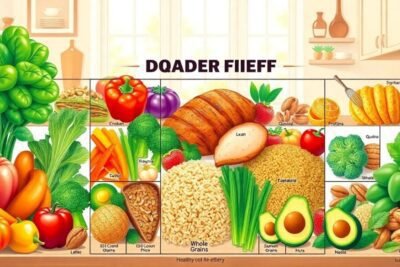
When it comes to cooking and baking, heavy cream is a staple ingredient known for its rich texture and luxurious taste. However, dietary restrictions or a simple lack of cream in your pantry may require you to find suitable alternatives. Whether you’re looking for a non-dairy option or just something a tad healthier, there's a variety of substitutes that can mimic the properties of heavy cream in your recipes. Cream instead of milk: Your Go-to Guide for Substitutions.
Understanding how to replace this key ingredient without compromising on taste or texture is essential for any culinary aficionado. Our guide offers a deep dive into the best heavy cream substitutes, ensuring you can continue to create delicious meals and desserts, even when you're out of the real deal.
What you\'ll find in this article?
- Can You Use Heavy Cream Instead of Milk?
- How to Dilute Heavy Cream to Substitute for Milk
- Top Non-Dairy Heavy Cream Substitutes
- How to Use Evaporated Milk as a Substitute
- The Best Vegan Substitutes for Heavy Cream
- Tips for Substituting Heavy Cream in Recipes
- Heavy cream substitute non dairy
- Can i use milk instead of heavy cream
- Can you substitute milk for heavy cream
- Can you use milk instead of cream
- Can cream substitute milk
- Can i substitute cream for milk
- Can i substitute milk for heavy cream
- Can i use
- Can i use milk instead of cream
- Can you use milk instead of heavy cream
- Dairy cream alternative
- Dairy free cream alternative
- Heavy cream non dairy
- Milk substitute for heavy cream
- Non dairy substitute for heavy cream
- Almond milk substitute for heavy cream
- Can heavy cream be substituted for milk
- Can heavy cream be used in place of milk
- Can i substitute almond milk for heavy cream
- Related Questions on Cream Substitutes
- Can i use heavy cream instead of milk
- Can i substitute milk for cream
- Can i use almond milk instead of heavy cream
- Can you substitute almond milk for heavy cream
- Can you substitute cream for milk in baking
- Dairy free substitute for heavy cream
- Dairy free heavy cream substitute
- Dairy free heavy cream alternative
- Dairy free cream substitute
- Can you substitute milk for cream
- How to substitute heavy cream for milk
- How to substitute milk for heavy cream
- How to use milk as heavy cream
- Instead of heavy cream can i use milk
- Is heavy cream a good substitute for milk
- Non dairy replacement for heavy cream
- Non dairy cream substitute
- Milk substitute cream
- Milk for heavy cream substitute
- Lactose free cream substitute
- Substitute cream for milk in baking
- Substitute milk for cream
- What\'s a dairy free substitute for heavy cream
Can You Use Heavy Cream Instead of Milk?
Many wonder if using cream instead of milk in recipes is possible, and the answer is yes—with some adjustments. Heavy cream, with its high fat content, can be diluted to mimic the lightness of milk. This allows for a flexible solution when milk is unavailable, or you desire a richer flavor profile in your dishes.
For each cup of milk required, you can combine three-quarters of a cup of heavy cream with a quarter cup of water to achieve the desired consistency. This makes it a perfect heavy cream substitute for milk, especially in recipes where the fat content is not critical to the final outcome, such as in soups and sauces.
However, it's important to note that this may not be suitable for all recipes, as the higher fat content will affect the texture and may cause dishes to become heavier than intended.








How to Dilute Heavy Cream to Substitute for Milk
Diluting heavy cream to use as a milk substitute is a straightforward process. Here’s how you can do it:
- Measure out the heavy cream based on the amount of milk your recipe calls for.
- Add water to the heavy cream to reduce the thickness. The standard ratio is 3 parts cream to 1 part water.
- Stir the mixture until it is well combined and use it as a one-to-one substitute for milk.
Keep in mind that the fat content will still be higher than regular milk, which may affect the final product, especially in baked goods, which might turn out denser.
Top Non-Dairy Heavy Cream Substitutes
For those who are lactose intolerant or following a vegan diet, non-dairy substitutes for heavy cream are essential. Here are several options that can replicate the creaminess of heavy cream without any dairy:
- Coconut cream: With a rich texture and subtle coconut flavor, it’s an excellent substitute for heavy cream in desserts and curries.
- Soy milk and olive oil: A combination that emulates the fat content of heavy cream, perfect for savory dishes.
- Almond milk and cornstarch: This mix thickens upon cooking, offering a consistency similar to that of heavy cream.
Each of these alternatives offers unique flavor profiles and health benefits, making them not only suitable substitutes but also interesting variations to explore in your culinary practices.
How to Use Evaporated Milk as a Substitute
Evaporated milk is a versatile and widely available ingredient that can serve as a heavy cream substitute. It’s milk that has been cooked down to allow some of the water content to evaporate, resulting in a denser product.
To use evaporated milk as a substitute, simply replace the heavy cream with an equal amount of evaporated milk. If you need a thicker consistency, you can add a tablespoon of cornstarch to thicken it up.
Keep in mind that evaporated milk is sweeter than heavy cream, which can be a benefit in desserts but may require some savory recipes to be adjusted for taste.
The Best Vegan Substitutes for Heavy Cream
Vegan substitutes for heavy cream need to offer both the creaminess and richness that heavy cream provides. Here are some of the best vegan substitutes for heavy cream:
- Silken tofu and soy milk: When blended, they create a smooth, creamy texture that is an excellent base for vegan creams and sauces.
- Cashew cream: Soaked cashews blended with water can create a rich, full-bodied cream substitute.
- Oat cream: Commercial oat creams are available, but you can also blend oat milk with oil to create a homemade version.
These options are not just for those following a vegan lifestyle; they are also ideal for anyone looking to explore healthier alternatives in their cooking and baking endeavors.
Tips for Substituting Heavy Cream in Recipes
When substituting heavy cream, keep these tips in mind to ensure the best possible results:
- Consider the recipe: Some substitutes may work better in certain types of recipes than others.
- Watch the fat content: Adjust the fat content of your substitute to match that of heavy cream as closely as possible.
- Texture is key: Aim for a similar texture to heavy cream to guarantee your recipe turns out as intended.
Experimenting with different substitutes can lead to new and exciting flavors, but always remember to taste as you go and adjust your recipe accordingly.
Heavy cream substitute non dairy
For those seeking a dairy-free alternative to heavy cream, coconut cream is an excellent choice. It has a rich texture and a mild coconut flavor, making it ideal for both sweet and savory dishes. Simply refrigerate a can of coconut milk, scoop out the solidified cream, and use it as a substitute.
Another great non-dairy substitute is cashew cream. To make it, blend soaked cashews with water until smooth. This creamy mixture can mimic the richness of heavy cream and works well in sauces, soups, and even desserts.
Silken tofu can also serve as a versatile substitute for heavy cream. When blended until smooth, it creates a creamy texture that can be used in both savory and sweet recipes. Add a bit of lemon juice or vanilla extract to enhance the flavor, depending on your dish.
Lastly, consider using soy milk combined with olive oil. Mixing 1 cup of soy milk with 2 tablespoons of olive oil can provide a creamy consistency that works well in various recipes, especially for cooking and baking.
Can i use milk instead of heavy cream
When considering a substitution, you might wonder, can I use milk instead of heavy cream? The answer is yes, but the texture and richness will differ significantly. Heavy cream contains a higher fat content, which contributes to a creamy consistency that milk lacks.
If you choose to use milk, it's advisable to add a thickening agent such as flour, cornstarch, or even a bit of butter to mimic the creaminess of heavy cream. This will help achieve a more similar texture in your dish.
Keep in mind that the flavor profile will also change. While milk can work in many recipes, it may not deliver the same depth of flavor that heavy cream provides, especially in rich sauces or desserts.
In baking, milk can often replace heavy cream in a pinch, but adjustments may be necessary for the best results. Consider increasing the quantity of butter or using whole milk to get closer to the desired consistency.
Ultimately, while you can substitute milk for heavy cream, the outcome may vary depending on the recipe. Experimenting with different combinations can help you find the right balance for your culinary needs.
Can you substitute milk for heavy cream
When considering whether milk can be substituted for heavy cream, it's important to note that the two have different fat contents. Heavy cream typically contains around 36% fat, while whole milk has only about 3.5%. This difference can affect the texture and richness of your dishes.
If you're looking to use milk instead of heavy cream in a recipe, you may need to adjust other ingredients to maintain the desired consistency. Adding a thickening agent, such as flour or cornstarch, can help achieve a creamier texture that resembles heavy cream.
For certain recipes, such as sauces or soups, milk can serve as a lighter alternative to heavy cream, but the flavor may be less rich. Consider using whole milk or adding a small amount of butter to enhance the taste and mimic the creaminess of heavy cream.
In baking, substituting milk for heavy cream is generally acceptable, especially in recipes that rely on moisture rather than fat for structure. However, keep an eye on the overall liquid content, as milk contains more water than heavy cream.
Ultimately, substituting milk for heavy cream is possible, but the outcome may vary depending on the dish. It's always a good idea to experiment and adjust your recipe to find the perfect balance that suits your taste and texture preferences.
Can you use milk instead of cream
When considering whether milk can be used instead of cream, it's important to recognize the differences in their fat content. Cream typically contains between 30% to 40% fat, while milk has only about 3% to 4%. This significant difference means that using milk will yield a lighter texture and flavor in your dishes.
If you're looking for a lower-calorie alternative, substituting milk for cream can be a wise choice. However, keep in mind that you may need to adjust your recipe to account for the thinner consistency of milk. Adding a thickening agent such as flour or cornstarch can help achieve a creamier texture.
In recipes that require a rich and creamy finish, like sauces or soups, milk can be used as a substitute, but the final result may lack the same depth of flavor. To enhance the richness, consider adding a bit of butter or cheese to your dish when using milk instead of cream.
For baking, substituting milk for cream may affect the moisture and texture of your final product. Many baked goods benefit from the creamy richness of heavy cream, so if you choose to use milk, be prepared for potential differences in both taste and consistency.
Ultimately, while you can use milk instead of cream in many recipes, the outcome may vary. It's often best to experiment and find the right balance that suits your taste preferences and the specific dish you're preparing.
Can cream substitute milk
Using cream as a substitute for milk can enhance the richness and flavor of many dishes. However, since cream is thicker and more concentrated, it may not be a direct one-to-one replacement. Adjusting the quantity is essential to achieve the desired consistency and taste.
When substituting cream for milk, it's important to consider the fat content. Cream has a much higher fat content than milk, which can affect the overall texture of your recipe. For lighter dishes, consider diluting cream with water or broth to mimic the consistency of milk.
In recipes that require cooking, such as soups or sauces, cream can provide a silky texture and a richer flavor profile. However, be cautious with cooking times, as cream can curdle if heated too quickly or to too high a temperature.
Baking with cream instead of milk can lead to moist and decadent results. For cakes or muffins, using cream can enhance the overall flavor and tenderness, but be mindful of the sugar content, as cream can make baked goods sweeter.
Ultimately, substituting cream for milk can be a delightful culinary experiment, adding a new dimension to your favorite recipes. Just remember to adjust your proportions accordingly to maintain balance in your dish.
Can i substitute cream for milk
When considering whether to substitute cream for milk, it's essential to keep in mind the differences in fat content. Cream typically contains much higher fat levels, which can significantly alter the texture and richness of your dish.
For recipes that require a creamy consistency, using can enhance the flavor profile. However, this substitution may not work well in all cases, especially where a lighter texture is desired.
If you're concerned about the calorie count, mixing cream with water can be a practical solution. This way, you can achieve a milk-like consistency while still enjoying some of the creaminess and richness.
In baking, substituting cream for milk can lead to richer and denser results. Keep this in mind when adjusting your recipes, as it may require some experimentation to get the desired outcome.
Ultimately, whether or not you can substitute cream for milk depends on the specific recipe and the effect you want to achieve. Always consider the overall balance of flavors and textures in your dish when making this choice.
Can i substitute milk for heavy cream
When considering whether milk can be substituted for heavy cream, it's essential to recognize the differences in fat content. Heavy cream typically contains around 36% fat, while whole milk has only about 3.25%. This substantial difference affects the texture and richness of your dishes.
If a recipe calls for heavy cream and you need to use milk instead, you might want to add some additional fat to achieve a creamier consistency. A common method is to mix whole milk with butter, using about 2 tablespoons of melted butter for every cup of milk.
Another option is to use milk combined with cornstarch as a thickening agent. By mixing 1 tablespoon of cornstarch with 1 cup of milk, you can create a similar texture to that of heavy cream, making it suitable for sauces and soups.
Keep in mind that while using milk instead of heavy cream can work in many recipes, the flavor and richness may not be identical. Adjustments in seasoning and cooking times may be necessary to achieve the desired results.
Can i use
When considering a substitution for milk in recipes, many wonder, can I use? The answer is yes, but with some important adjustments. Heavy cream is much thicker and richer, so it can alter the texture and flavor of your dish.
If you're using heavy cream as a milk substitute, it's advisable to dilute it with water to achieve a consistency closer to that of milk. A common ratio is to mix one part heavy cream with one part water. This helps maintain the intended texture of your recipes.
For baking purposes, using heavy cream can enhance the richness of cakes and pastries. However, if your recipe relies on milk for moisture, be mindful that heavy cream may result in a denser final product.
In savory dishes, such as soups or sauces, heavy cream can add a luxurious creaminess that elevates the flavor profile. Just remember to adjust the seasoning, as the cream can mute some flavors compared to milk.
Ultimately, substituting heavy cream for milk is a viable option, but it’s essential to consider the dish's overall balance. Experimentation may be necessary to find the perfect ratio that suits your taste and desired outcome.
Can i use milk instead of cream
When considering a recipe that calls for cream, you might wonder, can I use milk instead? While milk can be a suitable substitute, the results may differ in texture and richness. Cream has a higher fat content, which contributes to a creamier consistency that milk simply can't replicate.
If you decide to use milk as a substitute, it's best to choose whole milk for a closer match to cream. Low-fat or skim milk will produce a thinner result, which may affect the overall flavor and mouthfeel of your dish. Adding a bit of butter to whole milk can also help mimic the richness of cream.
In recipes like soups or sauces, using milk instead of cream can work, but you might need to adjust the cooking time. Milk tends to curdle if cooked at high temperatures for too long, so it's important to keep the heat moderate and stir frequently.
For baking, substituting milk for cream can alter the outcome of your dessert. Keep in mind that cakes or pastries may not rise as well if you use milk instead of cream. However, in some cases, a combination of milk and a thickening agent like cornstarch can help achieve the desired texture.
Ultimately, while you can use milk instead of cream in many recipes, be prepared for some adjustments in flavor and texture. It's always a good idea to experiment and find the right balance for your specific dish, ensuring that you still achieve a delicious result.
Can you use milk instead of heavy cream
When considering whether milk can replace heavy cream, it's important to note that the two have different fat contents. Heavy cream typically contains around 36% fat, while whole milk has only about 3.5%. This fat difference can significantly impact the texture and richness of your dish.
For recipes requiring whipping or thickening, substituting milk for heavy cream might not yield the desired results. However, you can create a makeshift heavy cream by combining milk with butter, which increases the fat content and mimics the cream's consistency.
In sauces and soups, milk can be used as a lighter alternative to heavy cream, but be prepared for a less creamy texture. To enhance the richness, consider adding a bit of flour or cornstarch to help thicken the mixture.
Ultimately, while milk can serve as a substitute for heavy cream in certain situations, adjustments may be necessary to achieve the desired flavor and consistency in your cooking or baking endeavors.
Dairy cream alternative
For those seeking a dairy cream alternative, options like coconut cream offer a rich and creamy texture that can easily replace traditional dairy. This plant-based option not only adds a unique flavor but is also suitable for vegans and lactose-intolerant individuals.
Another excellent substitute is cashew cream, made by blending soaked cashews with water. This versatile cream can be sweetened or flavored to match your recipe, making it perfect for both savory and sweet dishes.
Almond milk can also be enriched to create a lighter cream alternative. By combining almond milk with a thickening agent like cornstarch or arrowroot, you can achieve a similar consistency to dairy cream while keeping it dairy-free.
For a quick solution, soy cream is readily available in many grocery stores and serves as a direct substitute in recipes that require heavy cream. It has a similar taste and texture, making it a convenient choice for cooking and baking.
Dairy free cream alternative
If you're looking for a dairy free cream alternative, coconut cream is a fantastic choice. It adds a rich, creamy texture to recipes, making it perfect for soups, sauces, and desserts. Just chill a can of coconut milk overnight, then scoop out the solidified cream for the best results.
Another popular dairy free cream alternative is cashew cream. By soaking cashews and blending them with water, you can create a smooth and versatile cream that works well in both sweet and savory dishes. This option is not only creamy but also packed with nutrients.
For a lighter alternative, consider using almond milk mixed with a thickener like cornstarch or arrowroot powder. This dairy free cream alternative can mimic the consistency of cream without the heaviness, making it an excellent option for dressings and lighter sauces.
Oat cream has also emerged as a popular dairy free cream alternative. Its naturally sweet flavor and creamy texture make it a great addition to coffee, baked goods, and creamy pasta dishes. Plus, it's often easier to find in stores compared to other alternatives.
Lastly, soy cream is another viable dairy free cream alternative that can be used in a variety of recipes. It offers a similar taste and texture to dairy cream, making it an easy swap in your favorite dishes without sacrificing flavor.
Heavy cream non dairy
For those seeking a non-dairy alternative to heavy cream, options abound that can mimic the richness and texture of traditional cream. Coconut cream is one of the most popular substitutes, offering a creamy consistency and a hint of tropical flavor. It's perfect for desserts and can also be used in savory dishes.
Another excellent choice is cashew cream, made by blending soaked cashews with water until smooth. This nut-based cream is versatile and can be seasoned to suit both sweet and savory recipes, making it an ideal heavy cream replacement in sauces, soups, and desserts.
For those looking for a lighter option, soy cream can be a great substitute. It provides a similar consistency to heavy cream while being lower in fat. Additionally, soy cream can be used in both cooking and baking, making it a flexible choice for various culinary needs.
Oat cream is gaining popularity as a dairy-free alternative, particularly for those with nut allergies. Made from blended oats and water, it has a mild flavor that works well in coffee, soups, and baked goods, providing a creamy texture without the dairy.
Lastly, almond milk creamers are becoming increasingly available in stores. These creamers are designed to replicate the consistency of heavy cream, making them perfect for coffee and creamy sauces. With a variety of flavors available, they can add a unique twist to your dishes.
Milk substitute for heavy cream
When looking for a milk substitute for heavy cream, one of the best options is a combination of milk and butter. This mixture mimics the fat content of heavy cream, providing a rich texture without sacrificing flavor. Use three parts milk to one part melted butter for an effective replacement.
Coconut cream is another excellent alternative to heavy cream. It has a thick consistency and a slight sweetness, making it perfect for both savory and sweet dishes. Just refrigerate a can of coconut milk overnight, and scoop out the solidified cream for use in your recipes.
For a lighter option, consider using Greek yogurt. It offers a creamy texture and tangy flavor, ideal for dressings or dips. To replace heavy cream, simply thin it with a bit of milk or water to reach the desired consistency.
Silken tofu blended until smooth can also serve as a fantastic dairy-free substitute for heavy cream. This alternative works well in recipes that require a creamy texture, such as soups or desserts, while adding a boost of protein.
Non dairy substitute for heavy cream
If you're looking for a non-dairy substitute for heavy cream, coconut cream is a fantastic option. It has a rich and creamy texture that closely resembles heavy cream, making it ideal for sauces, soups, and desserts. Just refrigerate a can of coconut milk overnight, then scoop out the solidified cream for use.
Another excellent alternative is cashew cream, which is made by blending soaked cashews with water until smooth. This creamy substitute works well in both savory and sweet dishes, providing a nutty flavor that enhances the overall taste of your recipes.
For those seeking a lighter option, soy milk combined with oil can be a great choice. Mixing two tablespoons of oil with one cup of soy milk creates a heavy cream substitute that works well in baking and cooking, providing a similar richness without dairy.
Oat milk has also emerged as a popular non-dairy heavy cream substitute. When heated, it thickens beautifully and adds a subtle sweetness to your dishes. It’s especially useful in creamy soups and pasta sauces.
Lastly, you can try using almond milk with a thickening agent such as cornstarch or flour. By combining almond milk with a thickener, you can mimic the texture of heavy cream, making it suitable for various culinary applications without the dairy.
Almond milk substitute for heavy cream
When looking for a non-dairy alternative to heavy cream, almond milk is a popular choice. While it won't replicate the same richness, it can still provide a creamy texture for sauces and soups.
To achieve a closer consistency to heavy cream, consider thickening almond milk with a bit of cornstarch or flour. This simple addition helps mimic the velvety mouthfeel that heavy cream offers in recipes.
Almond milk can also be blended with silken tofu or cashews, creating a creamy mixture that works well in desserts and savory dishes alike. This combination enhances the flavor while maintaining a dairy-free profile.
For sweet recipes, using vanilla-flavored almond milk can add an extra layer of taste, making it an excellent substitute in custards and puddings. Just remember to adjust the sweetness of your dish accordingly.
Can heavy cream be substituted for milk
When it comes to cooking and baking, heavy cream can indeed be substituted for milk, but it’s important to consider the differences in texture and flavor. Heavy cream has a much richer and thicker consistency compared to regular milk, which can affect the final outcome of your dish.
If you decide to use, you may want to dilute it slightly with water to achieve a more similar consistency. A common ratio is to mix one part water with two parts heavy cream, which can help balance the richness without compromising the dish.
In recipes that require cooking, such as sauces or soups, substituting heavy cream for milk can enhance the creaminess and depth of flavor. However, keep in mind that this substitution may also increase the calorie content of your meal significantly.
For those watching their fat intake, using heavy cream as a milk substitute might not be ideal. In such cases, consider using alternatives such as evaporated milk, half-and-half, or a lighter cream, which can provide a similar texture with less fat.
Ultimately, using heavy can lead to delicious results, especially in desserts and creamy dishes. Just remember to adjust other ingredients accordingly to maintain the right balance in your recipe.
Can heavy cream be used in place of milk
Using heavy cream in place of milk is a common substitution in various recipes, especially when a richer flavor is desired. Heavy cream has a higher fat content, which means it can add a creamy texture to dishes that milk alone may not achieve. This makes it an excellent choice for sauces, soups, and desserts.
When substituting heavy cream for milk, it's important to consider the consistency of your dish. Heavy cream can be quite thick, so you may need to dilute it with water to match the consistency of milk. A good rule of thumb is to mix equal parts of heavy cream and water, which can help achieve a more similar texture.
Another advantage of using heavy cream is its ability to enhance flavors. The richness of heavy cream can enrich the taste of baked goods and creamy dishes, making them more indulgent. However, this can also mean that the final dish will be more caloric, so it's wise to use it sparingly if you're watching your intake.
In some cases, heavy cream can be used 1:1 in recipes that call for milk, especially in creamy soups or sauces where the thickness can be beneficial. However, for lighter recipes, such as pancakes or cakes, consider adjusting the amount or using a mixture of heavy cream and water to avoid overpowering the other ingredients.
Lastly, if you're looking for a dairy-free alternative, consider coconut cream, which can mimic the richness of heavy cream while being suitable for those with lactose intolerance. This substitution can also add a unique flavor to your dishes, making it a versatile option in various culinary applications.
Can i substitute almond milk for heavy cream
When considering a substitution for heavy cream, almond milk can be a viable option, especially for those seeking a dairy-free alternative. However, it's important to note that almond milk is much thinner in consistency.
To achieve a creamier texture, you may want to combine almond milk with a thickening agent, such as cornstarch or tapioca flour. This can help mimic the richness of heavy cream in recipes.
While almond milk can work well in sauces and soups, it may not provide the same level of richness required for desserts. Consider using almond milk in savory dishes where the flavor can complement other ingredients.
In baking, almond milk can be substituted for heavy cream, but be prepared for a slight difference in taste and texture. Adjusting other ingredients may be necessary to achieve the desired outcome.
Can You Use?
Yes, cream can be used instead of milk in most recipes by diluting it with water to match the consistency of milk. This can lead to a richer, more decadent flavor in your dishes.
However, because cream is thicker and has a higher fat content than milk, its use should be tailored to the recipe to prevent altering the final product's texture too much.
Can I Use Table?
Table cream, which is lighter than heavy cream, can also be used as a substitute for milk. Its lower fat content makes it a closer match to milk, and it may not require dilution, depending on the recipe.
Adjusting the ratio of table cream to water can help you achieve the desired consistency for various recipes, from soups to baked goods.
What Can I Use if I Don't Have Milk?
If you're out of milk, there are several options you can turn to:
- Water and butter: A combination that can substitute for milk in baking.
- Non-dairy milk: Almond, soy, and oat milks are great alternatives, especially for those with dietary restrictions.
- Yogurt or sour cream: These can replace milk in recipes to add richness and tang.
Each of these alternatives may affect the flavor and consistency of your dish, so choose one that complements the other ingredients and the overall dish.
Is Cream Better for You Than Milk?
Whether cream is "better" for you than milk largely depends on your dietary needs and goals. Cream is higher in fat and calories, which might be advantageous for those looking to increase their caloric intake or for certain culinary applications.
On the other hand, milk is lower in fat and calories and can be a better choice for those watching their intake. It also contains more lactose, making it unsuitable for lactose-intolerant individuals.
To incorporate these substitutes into your cooking and baking repertoire, be sure to consider not just the flavor they will bring to your dishes, but also the nutritional aspects. With the variety of options available, you can easily find a heavy cream substitute that meets your needs, whether you're looking for a non-dairy alternative or simply trying to use what you have on hand. Happy cooking!
Can i use heavy cream instead of milk
Using heavy cream instead of milk is a common substitution in various recipes, especially when you desire a richer flavor and creamier texture. Heavy cream contains a higher fat content, typically around 36-40%, compared to milk, which is about 3-4%. This difference can significantly influence the final dish, making it more indulgent.
When considering this substitution, it's essential to adjust the proportions accordingly. A useful guideline is to mix equal parts of heavy cream and water to mimic the consistency of milk. This blend will help ensure your recipes maintain the intended flavor and texture without being overly rich. Here’s a simple comparison:
| Ingredient | Fat Content | Best Use |
|---|---|---|
| Heavy Cream | 36-40% | Rich sauces, desserts |
| Milk | 3-4% | Baking, lighter dishes |
Keep in mind that substituting heavy cream for milk may alter the cooking time and techniques, particularly in baking. Monitor your dish closely to prevent overcooking or burning, as the higher fat content can change how ingredients react during the cooking process. In summary, heavy cream can be a fantastic alternative to milk, just remember to adjust the quantities and cooking methods as needed.
Can i substitute milk for cream
When considering whether milk can be substituted for cream, it’s essential to understand the differences in texture and fat content. Cream is significantly richer, providing a thicker consistency and a creamier taste, while milk is lighter and more fluid. This difference can impact the final outcome of your recipe, especially in dishes where creaminess is key.
In many cases, you can substitute milk for cream, but adjustments may be necessary. Here are some tips to consider:
- For cooking: Use whole milk or add a thickening agent like cornstarch or flour.
- For baking: Consider using evaporated milk as a closer substitute.
- For sauces: A mixture of milk and butter can mimic the richness of cream.
It’s important to note that substituting milk for cream may alter the flavor profile and texture of your dish. If the recipe heavily relies on the creaminess of cream, it might be beneficial to explore alternatives that can better replicate its properties, such as half-and-half or even coconut cream for a dairy-free option.
Ultimately, while you can substitute milk for cream in many recipes, the end result may vary. Always taste and adjust as needed, and consider the purpose of cream in your dish to achieve the best outcome.
Can i use almond milk instead of heavy cream
When considering whether to use almond milk instead of heavy cream, it's essential to understand the differences in texture and fat content. Almond milk is much lighter and has a thinner consistency compared to heavy cream, which can affect the overall richness of your dish.
For recipes where heavy cream is essential for thickness and creaminess, almond milk may not provide the desired outcome. However, with the right adjustments, it can still be a viable substitute in certain dishes. Here are some tips to make the substitution work:
- Use a thickener: Add cornstarch or arrowroot powder to almond milk to mimic the texture of heavy cream.
- Combine with nut butter: Mixing almond milk with a bit of almond butter can enhance creaminess.
- Consider adding a fat source: Incorporating coconut oil or vegan butter can help achieve a richer mouthfeel.
In summary, while almond milk can be used in place of heavy cream in some recipes, it's important to make adjustments to ensure the best results. For creamy sauces or soups, consider blending in a few additional ingredients for optimal texture and flavor.
Can you substitute almond milk for heavy cream
When considering whether you can substitute almond milk for heavy cream, it's important to understand the differences in texture and richness between the two. Almond milk is a plant-based milk alternative that is much lighter and thinner than heavy cream, which contains a high fat content. This means that while almond milk can replace heavy cream in some recipes, it may not provide the same creamy texture or richness.
For recipes that require heavy cream for its thickness and stability, such as in sauces or certain desserts, you might need to make some adjustments when using almond milk. One common method is to combine almond milk with a thickening agent like cornstarch or flour to help achieve a creamier consistency. Here are some tips for using almond milk as a substitute:
- Use 1 cup of almond milk mixed with 2 tablespoons of cornstarch for a thicker result.
- Consider adding a splash of oil or vegan butter to enhance the creaminess.
- For sweet dishes, a little sugar or maple syrup can help mimic the richness of heavy cream.
Ultimately, while almond milk can serve as a substitute for heavy cream in certain recipes, it may require some experimentation to get the desired outcome. It's best suited for dishes where the heavy cream's texture is less critical, such as smoothies or soups, rather than in rich desserts that rely heavily on the indulgent characteristics of cream.
Can you substitute cream for milk in baking
When it comes to baking, substituting cream for milk can yield rich and delicious results. Cream is thicker and has a higher fat content than milk, which can enhance the texture and flavor of baked goods. However, it's essential to adjust your recipe accordingly, as the substitution can alter the overall moisture and density of the final product.
If you're considering this substitution, keep in mind that you may want to dilute the cream to mimic the consistency of milk. A common approach is to mix equal parts of cream and water, which will help achieve a balance that works well in recipes. This method ensures that your baked goods maintain the right moisture level without becoming too heavy.
Here are a few types of baked goods where substituting cream for milk can have a positive impact:
- Cakes: Cream can add a velvety texture and richness.
- Cookies: Using cream can create a chewier and more decadent cookie.
- Custards and Puddings: Cream enhances creaminess and flavor depth.
Ultimately, while you can substitute cream for milk in baking, it's crucial to consider the specific recipe and desired outcome. Adjusting the liquid content and being mindful of the fat ratio will help you achieve the best results in your baked creations.
Dairy free substitute for heavy cream
If you're looking for a dairy-free substitute for heavy cream, there are several delicious options that can seamlessly replace it in your recipes. These alternatives not only provide a similar texture but also add unique flavors to your dishes. Consider using the following substitutes:
- Coconut Cream: This rich, thick cream can be whipped and used in desserts or savory dishes.
- Cashew Cream: Blending soaked cashews with water creates a creamy texture perfect for sauces and soups.
- Silken Tofu: Blended silken tofu can mimic the consistency of heavy cream, making it great for both sweet and savory recipes.
- Almond Milk with Oil: Mixing almond milk with a bit of oil can help achieve a similar richness.
When choosing a dairy-free substitute, it's essential to consider the flavor profile of your dish. For instance, coconut cream works well in tropical desserts, while cashew cream is more versatile for savory sauces. You can experiment with these options to find the perfect match for your culinary creations.
Here's a quick comparison table of these substitutes, highlighting their characteristics:
| Substitute | Texture | Flavor | Best Used In |
|---|---|---|---|
| Coconut Cream | Thick | Sweet, tropical | Desserts, curries |
| Cashew Cream | Creamy | Neutral, nutty | Soups, dips |
| Silken Tofu | Smooth | Neutral | Sauces, smoothies |
| Almond Milk with Oil | Liquid | Nuts, mild | Baking, sauces |
By choosing the right dairy-free substitute for heavy cream, you can enjoy your favorite recipes without compromising on taste or texture. Don’t hesitate to experiment with these alternatives to find the one that suits your dish best!
Dairy free heavy cream substitute
For those seeking a dairy-free heavy cream substitute, there are several options that can effectively mimic the richness and texture of traditional heavy cream. These alternatives are ideal for vegans, lactose-intolerant individuals, or anyone looking to reduce dairy in their diet.
One popular choice is coconut cream, which is made by refrigerating a can of coconut milk and scooping out the thick cream that forms at the top. This option provides a rich, creamy texture and a subtle coconut flavor, making it suitable for both sweet and savory dishes.
Another excellent substitute is cashew cream. To make it, simply soak raw cashews in water for several hours, then blend them with a little water until smooth. This creamy concoction can be used in sauces, soups, and desserts, offering a neutral flavor that can easily absorb spices and other ingredients.
Here’s a quick comparison of dairy-free heavy cream substitutes:
| Substitute | Texture | Flavor | Best Uses |
|---|---|---|---|
| Coconut Cream | Thick and creamy | Coconut flavor | Desserts, curries |
| Cashew Cream | Smooth and creamy | Neutral | Soups, sauces, desserts |
| Silken Tofu | Creamy | Neutral | Smoothies, dressings |
Dairy free heavy cream alternative
For those seeking dairy-free heavy cream alternatives, there are several excellent options available that can mimic the richness and texture of traditional cream. These substitutes are not only suitable for vegans but also for anyone with lactose intolerance or dairy allergies. Below are some popular alternatives:
- Coconut Cream: This thick, rich cream is made from the flesh of coconuts and is perfect for adding a creamy texture to soups and desserts.
- Cashew Cream: Blended soaked cashews create a smooth and creamy texture, ideal for sauces and soups.
- Soy Cream: A plant-based option that can be used in a variety of culinary applications, soy cream is often fortified to enhance its nutritional profile.
- Oat Cream: Made from oats, this alternative has a mild flavor and works well in both sweet and savory dishes.
When choosing a dairy-free heavy cream alternative, consider the flavor profile and the intended use in your recipe. Some options may work better for cooking, while others shine in baking or desserts. Here’s a quick comparison:
| Alternative | Flavor | Best For |
|---|---|---|
| Coconut Cream | Sweet, tropical | Desserts, curries |
| Cashew Cream | Nutty, rich | Sauces, soups |
| Soy Cream | Mild | All-purpose |
| Oat Cream | Neutral | Baking, coffee |
Experimenting with these alternatives can lead to delicious results in your favorite recipes. Always remember to adjust seasoning and cooking times as necessary, as each substitute may behave differently in various dishes.
Dairy free cream substitute
For those seeking a dairy-free cream substitute, there are several delicious options available that can seamlessly replace traditional cream in recipes. These alternatives are perfect for vegans, those with lactose intolerance, or anyone looking to reduce dairy intake. From nut-based creams to coconut options, the choices are diverse and flavorful.
One popular option is coconut cream, which provides a rich and creamy texture. It can be whipped to create a fluffy topping or used in savory dishes for added richness. To make coconut cream, simply refrigerate a can of coconut milk and scoop out the solidified cream that forms at the top.
Another excellent choice is cashew cream. To make it, soak cashews in water, then blend them with a bit of water until smooth. This creamy substitute works wonderfully in soups, sauces, or desserts. Additionally, it can be seasoned to enhance its flavor profile, making it incredibly versatile.
For those needing a quick and easy option, store-bought dairy-free creamers are also widely available. These products come in various flavors and formulations, often made from almond, soy, or oat milk. When selecting a store-bought alternative, check the ingredient list to ensure it meets your dietary needs.
Can you substitute milk for cream
When considering whether you can substitute milk for cream, it's important to recognize that they have different properties. Cream is richer and has a higher fat content than milk, which can impact the texture and flavor of your dish. However, in some recipes, particularly those that require a creamy consistency, milk can be an acceptable substitute with a few adjustments.
To mimic the richness of cream when using milk, you can try the following methods:
- Add butter: For every cup of milk, add 1-2 tablespoons of melted butter to increase the fat content.
- Use a thickener: Incorporate cornstarch or flour to achieve a creamier texture.
- Combine with other ingredients: Blending milk with yogurt or sour cream can enhance creaminess.
It's worth noting that while milk can serve as a substitute for cream in many recipes, it may not work well in all cases. For instance, when making sauces that require a rich base, the lower fat content of milk may result in a less satisfying flavor. Always consider the specific requirements of your recipe before making the switch.
In summary, while you can substitute milk for cream in certain situations, the results may vary. Here is a quick comparison of the two:
| Aspect | Milk | Cream |
|---|---|---|
| Fat Content | 3-5% | 30-40% |
| Texture | Thinner | Thicker and creamier |
| Flavor | Light | Rich |
How to substitute heavy cream for milk
Substituting heavy cream for milk can enhance the richness and texture of your recipes. To achieve a similar consistency, you can dilute heavy cream with water. A common ratio is 1 part heavy cream to 1 part water. This mixture will create a lighter version that closely resembles whole milk.
Another effective method is to use heavy cream in combination with other ingredients. For example, you can mix heavy cream with buttermilk or yogurt to add tanginess while maintaining the creaminess. A simple ratio to consider is ¾ cup heavy cream mixed with ¼ cup buttermilk to replace 1 cup of milk.
If you are looking for a dairy-free option, consider blending heavy cream with nut milk like almond or coconut milk to create a creamy substitute. This not only caters to lactose intolerance but also adds unique flavors to your dishes. A good starting point is ½ cup heavy cream mixed with ½ cup nut milk for a perfect balance.
Here’s a quick comparison of how various substitutes stack up against heavy cream and milk:
| Substitute | Ratio for 1 Cup of Milk | Flavor Profile |
|---|---|---|
| Heavy Cream + Water | 1 cup heavy cream + 1 cup water | Rich and creamy |
| Heavy Cream + Buttermilk | ¾ cup heavy cream + ¼ cup buttermilk | Rich with tang |
| Heavy Cream + Nut Milk | ½ cup heavy cream + ½ cup nut milk | Creamy with nutty flavor |
How to substitute milk for heavy cream
When looking to substitute milk with heavy cream, it's important to consider the fat content. Heavy cream has a much richer flavor and thicker consistency, so you'll need to adjust your recipe accordingly. Typically, you can substitute heavy cream for milk at a ratio of 1:1, but for a lighter version, you can dilute it with water.
To create a mixture that mimics the consistency of milk, combine heavy cream with water. Use the following guideline:
- 1 part heavy cream
- 1 part water
This mixture can be useful in recipes like soups or sauces where you want the creaminess without the full richness of heavy cream. Additionally, consider using this substitution in baking, as it will provide moisture and richness to your baked goods.
Remember that when using heavy cream in place of milk, you may need to adjust other ingredients, especially sweeteners, as the flavor profile will be different. Always taste your dish as you go to ensure the best results!
How to use milk as heavy cream
If you find yourself in need of heavy cream but only have milk on hand, you can create a suitable substitute with a few simple ingredients. By combining milk with a fat source, you can mimic the richness and texture of heavy cream. Here’s a straightforward method to achieve this:
To make a heavy cream substitute using milk, follow these steps:
- Combine 1 cup of whole milk with 1/3 cup of unsalted butter.
- Melt the butter and then mix it with the milk until well blended.
- Use this mixture in your recipe as a 1:1 replacement for heavy cream.
For those who prefer a lighter option, you can also use a mixture of milk and cornstarch. This method helps thicken the milk, making it closer in consistency to heavy cream:
- Mix 1 cup of milk with 2 tablespoons of cornstarch.
- Whisk the mixture until the cornstarch is fully dissolved.
- Heat gently until it thickens to your desired consistency.
Keep in mind that while these substitutes can replicate the texture of heavy cream, the flavor might differ slightly. Always consider the overall taste of your dish when making substitutions. Here’s a quick comparison:
| Substitute | Texture | Fat Content | Best For |
|---|---|---|---|
| Milk + Butter | Creamy | High | Soups, Sauces |
| Milk + Cornstarch | Thickened | Medium | Desserts, Baking |
Instead of heavy cream can i use milk
When considering whether to use milk instead of heavy cream, it's important to understand the differences in texture and flavor. Heavy cream is thicker and richer, providing a creamy mouthfeel that milk simply cannot replicate. However, in certain recipes, especially when cooking or baking, milk can serve as a suitable substitute if adjusted properly.
To replace heavy cream with milk, you can use a combination of milk and fat to achieve a similar consistency. For every cup of heavy cream, you can mix 2/3 cup of milk with 1/3 cup of butter to mimic the richness of heavy cream. This blend can work well in sauces, soups, and even some dessert recipes.
Keep in mind that using milk instead of heavy cream may alter the final result in terms of flavor and richness. If you are making whipped toppings or anything that requires a stable structure, consider using alternatives like Coconut cream or a commercial non-dairy whip. Here are some alternatives:
- Half-and-half
- Greek yogurt
- Silken tofu blended with milk
- Cashew cream
In conclusion, while you can use milk instead of heavy cream, be prepared for potential changes in taste and texture. Adjusting your recipe can help you achieve a satisfying result that still complements your dish.
Is heavy cream a good substitute for milk
When considering whether heavy cream is a good substitute for milk, it's important to note that it offers a much richer flavor and thicker consistency. This makes it an excellent choice for recipes that benefit from added creaminess, such as sauces, soups, and desserts. However, it may not be suitable for every application, especially in beverages or lighter dishes where a milder flavor is desired.
To effectively use heavy cream as a milk substitute, you may want to dilute it. Mixing equal parts of heavy cream and water can create a consistency closer to that of whole milk. This dilution can help maintain the intended texture and flavor of the dish while still providing the richness that heavy cream brings.
Here are some key considerations when substituting heavy cream for milk:
- Flavor: Heavy cream is much richer and can overwhelm delicate flavors.
- Texture: It adds a velvety texture, which can enhance creamy dishes.
- Fat content: Heavy cream contains significantly more fat than milk, which can alter the nutritional profile of your dish.
In summary, while heavy cream can be a good substitute for milk in many recipes, it is essential to consider the dish's overall flavor and texture. For lighter recipes, consider using a diluted version to achieve the best results without compromising on taste.
Non dairy replacement for heavy cream
For those seeking non-dairy replacements for heavy cream, there are several excellent options that can mimic the rich texture and flavor. One popular choice is coconut cream, which is thick and creamy, making it ideal for both sweet and savory dishes. Just be sure to use the thick part from a can of full-fat coconut milk for the best results.
Another great alternative is silan or cashew cream. To make cashew cream, simply blend soaked cashews with water until smooth. This versatile cream can be seasoned to match the dish you're preparing, making it a perfect substitute in sauces or soups.
For a lighter option, consider silken tofu blended with plant-based milk. This combination provides a creamy texture without being overly heavy. It works well in desserts like mousses or puddings, where a subtle flavor is desired.
Here’s a quick comparison of some non-dairy replacements for heavy cream:
| Replacement | Texture | Best Uses |
|---|---|---|
| Coconut Cream | Thick and Rich | Desserts, Curries |
| Cashew Cream | Creamy | Soups, Sauces |
| Silken Tofu | Smooth | Desserts, Dressings |
Non dairy cream substitute
If you're looking for a non-dairy cream substitute, there are several delicious options that can enhance your recipes without using animal products. These alternatives not only cater to dietary restrictions but also bring unique flavors and textures to your dishes. Here are some popular choices:
- Coconut Cream: This rich and creamy option works well in both sweet and savory dishes. It adds a subtle coconut flavor and is perfect for desserts.
- Almond Cream: Made from blended almonds, this substitute has a nutty flavor and is great for sauces, soups, and coffee.
- Cashew Cream: Soaked and blended cashews create a smooth, thick cream that can be used in pasta sauces and desserts.
- Soy Cream: A versatile option that mimics dairy cream closely, soy cream is perfect for whipping and pouring over dishes.
When substituting non-dairy cream for milk, keep in mind that the consistency and flavor might differ. It's essential to adjust the quantity based on the richness of the alternative you choose. For instance, if a recipe calls for one cup of milk, you might only need half a cup of coconut cream due to its high fat content.
Additionally, consider how each non-dairy cream substitute will affect the overall taste of your dish. For example, using coconut cream in a savory recipe could introduce an unexpected sweetness. To ensure the best results, start with a small amount and adjust according to your taste preferences.
Milk substitute cream
When you're in a pinch and need a milk substitute, cream can be an excellent alternative, particularly in recipes that require richness and depth of flavor. Using cream instead of milk can elevate your dishes, adding a velvety texture and enhancing the overall taste. However, it's important to consider the differences in fat content and how they may affect the final outcome of your recipe.
Here are some common milk substitutes for cream that you can use in your cooking and baking:
- Half-and-half: A mix of equal parts cream and milk, perfect for coffee or light sauces.
- Coconut cream: Ideal for vegan dishes, it adds a tropical flavor and creamy texture.
- Greek yogurt: For a tangy twist, use it in savory recipes or dressings.
- Silken tofu: Blended, it serves as a great dairy-free option for sauces and desserts.
When substituting cream for milk, keep in mind the ratio you need to maintain. Generally, you can use a 1:1 ratio, but if you want to keep the creaminess without overwhelming richness, consider diluting the cream with water.
| Substitute | Ratio to Use | Best For |
|---|---|---|
| Half-and-half | 1:1 | Coffee, sauces |
| Coconut cream | 1:1 | Vegan recipes, desserts |
| Greek yogurt | 1:1 | Dressings, dips |
| Silken tofu | 1:1 | Sauces, smoothies |
Milk for heavy cream substitute
When you're in a pinch and need a substitute for heavy cream, milk can serve as a base, but it requires some modification to achieve a similar richness. One common method is to combine milk with butter, which adds the necessary fat content. For every cup of heavy cream needed, mix 3/4 cup of milk with 1/4 cup of melted butter.
Another option is to use whole milk or half-and-half if you have them on hand. While these won't provide the same thickness as heavy cream, they can work well in recipes where the cream's consistency is not crucial. Simply use the same amount as you would heavy cream, but be prepared for a slightly different texture.
If you're looking for a non-dairy option, consider using coconut milk or soy milk mixed with a little oil. This combination can mimic the creaminess of heavy cream and is perfect for vegan recipes. For best results, use full-fat coconut milk and blend it with a neutral oil in equal parts.
In summary, here are some effective substitutes for heavy cream using milk:
- 3/4 cup milk + 1/4 cup melted butter
- 1 cup whole milk or half-and-half
- 1 cup coconut milk or soy milk + 1 tablespoon oil
Lactose free cream substitute
If you're looking for a lactose-free cream substitute, there are several options that can provide the same rich texture and flavor without the lactose. One popular alternative is coconut cream, which is thick and creamy, making it a great choice for desserts and sauces. Another option is soy cream, which is made from soy milk and can be used in both sweet and savory dishes.
For those who prefer a nut-based alternative, almond cream is a fantastic choice. It has a slightly nutty flavor and works well in coffee or as a topping for desserts. Additionally, oat cream has become increasingly popular due to its creamy consistency and versatility, making it suitable for various recipes.
When selecting a lactose-free cream substitute, consider the following factors:
- Flavor Profile: Match the substitute with the dish.
- Texture: Ensure it mimics the creaminess you desire.
- Cooking Properties: Check if it can be heated without separating.
In conclusion, whether you choose coconut, soy, almond, or oat cream, there are plenty of delicious lactose-free options available. Experimenting with these substitutes can lead to delightful new flavors and textures in your cooking and baking.
Substitute cream for milk in baking
When substituting cream for milk in baking, it's essential to consider the fat content. Cream generally contains about 36-40% fat, while milk has only 3-4%. This difference can significantly impact the texture and richness of your baked goods. To achieve a similar consistency, you may want to dilute the cream with water or broth.
For a smooth substitution, use a ratio of 1:1 when replacing milk with cream, but remember to adjust the liquid content in your recipe. If the recipe calls for a cup of milk, you can use a cup of cream, yet consider adding some water to balance the richness. A common guideline is to mix one part water with two parts cream for optimal results.
Here are some tips to keep in mind when substituting cream for milk in baking:
- Use heavy cream for a denser product, such as cakes and brownies.
- For lighter options, consider using whipping cream instead.
- Adjust baking times as necessary, as cream can lead to quicker browning.
Overall, using cream in place of milk can enhance the flavor and richness of your baked treats. Just be mindful of the adjustments needed for liquid ratios and baking times to ensure delicious results.
Substitute milk for cream
When you need to substitute milk for cream in a recipe, there are several options to consider, depending on the desired consistency and flavor. One simple solution is to use a mixture of milk and butter. This combination mimics the richness of cream and can be adjusted to suit your needs.
To create a homemade substitute, use the following ratio:
- For every 1 cup of cream: Mix 3/4 cup of milk with 1/4 cup of melted butter.
Another alternative is to use evaporated milk, which has a thicker consistency than regular milk. This can be a great option for adding creaminess to soups, sauces, or desserts without the extra fat of cream.
If you're looking for a non-dairy option, consider using coconut milk or silken tofu blended with water. These substitutes can provide a creamy texture while catering to dietary restrictions, making them ideal for vegan recipes.
What\'s a dairy free substitute for heavy cream
Finding a dairy-free substitute for heavy cream can be essential for those with lactose intolerance or dietary restrictions. Fortunately, there are several delicious alternatives that can mimic the rich texture and flavor of heavy cream in your recipes. Here are some popular options to consider:
- Coconut Cream: This thick and creamy substance is derived from the meat of coconuts, providing a rich flavor perfect for desserts and sauces.
- Cashew Cream: Made by blending soaked cashews with water, this option creates a smooth, creamy consistency ideal for soups and pasta dishes.
- Silken Tofu: When blended, silken tofu offers a creamy texture that works well in both sweet and savory recipes.
- Almond Milk Cream Alternative: Blending almond milk with a thickener, like cornstarch, can give you a lighter cream option suitable for various dishes.
When substituting heavy cream, it's important to consider the intended use in your recipe. Some dairy-free alternatives can be better suited for cooking, while others shine in baking or dessert-making. Here's a quick comparison:
| Substitute | Best For | Flavor Profile |
|---|---|---|
| Coconut Cream | Desserts, Sauces | Rich and Tropical |
| Cashew Cream | Soups, Pasta | Neutral and Creamy |
| Silken Tofu | Baking, Smoothies | Mild and Versatile |
| Almond Milk Cream | Cooking, Baking | Nuts and Light |
By exploring these dairy-free substitutes for heavy cream, you can easily create delicious and creamy dishes without compromising on flavor or texture. Experiment with these alternatives to find the best fit for your culinary needs!












